Hasegawa 1/48 Voyager
|
KIT #: |
SW-02 |
|
PRICE: |
105 yuan RMB |
|
DECALS: |
None |
|
REVIEWER: |
Richard F |
|
NOTES: |
|
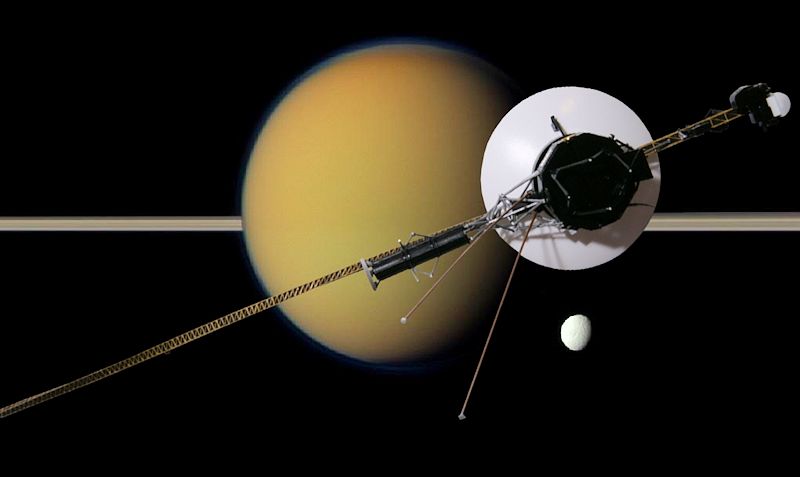
In John Carpenter's 1984 sci-fi classic, "Star Man", Voyager 2 blasts
through the universe to the Rolling Stones' "Satisfaction". An alien finds
it, listens to the Golden Record, flies to earth on a mission of peace, and
gets shot down by the same government that invited him here in the first
place. If it wasn't for the Star Man's gutsy new Earthling girlfriend,
played by Karen Allen (best known for her role as Indy's hot and feisty ex
girlfriend in Raiders of the Lost Ark), the Star Man never would have got
off that miserable rock they call "Earth".
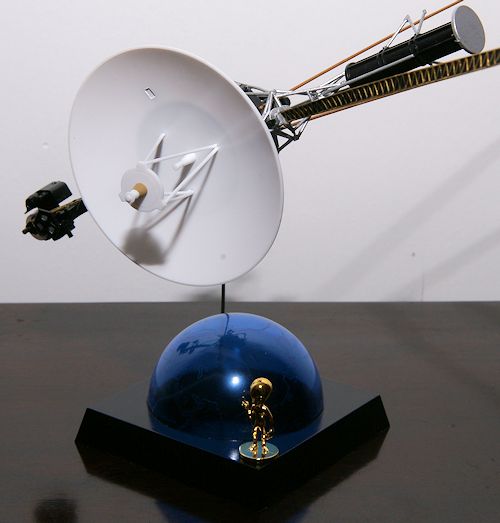
Voyager
is a really remarkable pair of spacecraft. Both 1 and 2 were launched in
1977, originally designed to fly by Jupiter and Saturn as Pioneers 10 and 11
had done, but with better instruments. But thanks to a once-in-several
lifetimes planetary alignment, engineers were able to send Voyager 2 on a
"planetary grand tour". By clever flying, the probe used gravity assists
from each fly-by to fling itself towards the next giant planet. After
zooming past Saturn in 1981, it cruised through space towards Uranus,
reaching it in 1986, and sling-shotting from there onwards to Neptune. It
reached Neptune in 1989 and is still flying outwards (as is Voyager 1).
Voyager 2 is humming along at more than 15.4 kilometers
per second - that's 34,500 miles per hour. Even though it flew past Neptune
in 1989, nearly 25 years ago, and it's been going really very fast, it is
only now reaching the real edge of the solar system, the place where the
sun's solar wind dies and washes into the intergalactic wind, a bit like a
river washing into the sea. This place is known as the "heliopause" and both
Voyagers are navigating toward it at the moment. In mid 2012 it was more
than twice as far from the Sun as Pluto but not yet beyond the outer limits
of the orbit of the dwarf planet Eris. The Solar System is a very big place.
One day - and it'll be a long time coming - the two probes might drift
alongside a passing star cruiser of some alien race. They're not headed in
the direction of any particular star, so they'll need to be found by
spacefarers.
And here's were we get back to that Golden Record.
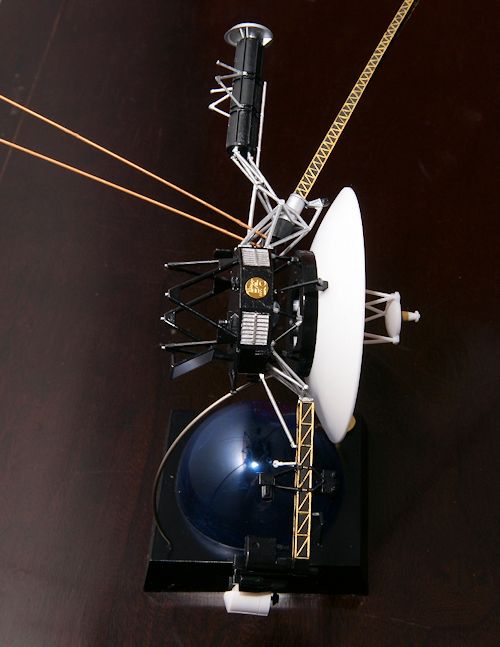
I only
have one concern about the wisdom of the Golden Record. I'm not worried
about a real-life re-run of Star Man. If an alien can really make to earth,
I'm sure he can handle himself without Indiana Jones' girlfriend. And no, I
don't fear that aliens will discover it, then us, and come and wipe us out
with ray guns or some weird galactic venereal disease we have no genetic
immunity to. I have a different concern. And I can't blame Carl Sagan, who
advocated for the record. I mean, they hadn't thought up CDs then, right?
Much less the mp3. A record probably made sense in 1977. But the record has
a different cultural meaning now.
No, instead of death rays and the space-clap, I worry that they'll see a
record on Voyager and immediately think we're a population of skinny-jeans
wearing, soy latte sipping, irony-dripping D-bags who wear chunky glasses
like McGeorge Bundy despite the fact they have 20-20 vision.
Yes, I'm worried that from now until the end of time a probe with a record
("so retro, dude!") mounted on its side is out there saying: "Greetings from
Planet Hipster".
Perhaps that's why the Klingon cruiser blasted Voyager into smithereens in
Star Trek VI. The gunner was all like: "Really? Another hipster Earth probe
with a record on it? I'm like so totes over this irony meme, man". Zzzz-wap!
Blammo.
Well, at least by the time some alien finds it, it really will be "vintage".
This excellent kit was
previewed right here on MM:
It's made black
and white plastic, handy because it is mostly black or white, and aimed at
kids or those who haven't made many models before. I finally get why
everyone likes Hasegawa, too. This kit is very cleverly laid out, and very
cleanly moulded. The big white dish is flawless. Some of the smaller parts
do require a tiny little bit of cleanup, mostly the various cylindrical
bits.
If you've
wanted a Voyager but baulked at the skill needed to build the epic Real
Space Models resin and PE version in 1/24 (also
previewed on MM: ) then maybe this is for
you.
This one is full
of sub-assemblies. There is the main "bus", the black decagon in the middle,
then there's the dish and its struts, and then there are the science
instruments and the power pack (a radioisotope thermoelectric generator,
otherwise known as a box full of plutonium). Each of these sub components
can be assembled separately and then all put together.
The fit is
amazing and this truly is a snap-tite kit - if you want it to be. Most of
the joins were so strong and precise that I didn't bo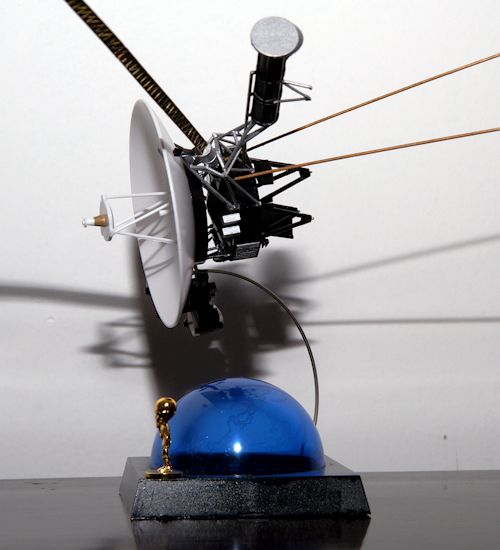 ther
gluing them. In a few spots, primarily on that complex system of booms and
pylons that holds the long golden instrumentation boom, I used a couple of
drops of superglue.
ther
gluing them. In a few spots, primarily on that complex system of booms and
pylons that holds the long golden instrumentation boom, I used a couple of
drops of superglue.
Once all the sub components are prepared, the instructions suggest a
workflow to attach them all to the "bus". I decided to put the high gain
antenna (the big white dish) on first, because I figured that putting it on
last like the instructions propose would just increase the likelihood of
wrecking all the booms. Doing it in reverse worked pretty well. The way the
kit goes together, there is a hole in the dish. You can see it pretty
clearly in the front-on photos. I decided not to fill this and sand it, on
the basis that it would be quite a bit of work to get that dish looking nice
afterwards, and that except in photos like these, it actually isn't that
noticeable. But by all means, go ahead and do that if you prefer. It would
look better if it was fixed up.
Be careful to
look at the instructions carefully for the proper orientation of the smaller
parts (little thrusters and various instrument packages). The painting guide
diagram is useful here too, because some of the drawings in the actual
instructions, while clearly drawn, are still a bit unclear on a few of these
points.
The hardest part
was getting the long black tube (the probe's power system, the radioisotope
thermoelectric generator or RTG) to attach to its mounting. I couldn't get
the locator pins all the way in, and rather than dismantling the whole
thing, or risk breaking something, I got it to a point where it was attached
soundly and left it like that. Some careful touchups with silver paint
helped the illusion. You only notice if you stare at it from a very close
distance.
Overall, with a
bit of care, this went together very smoothly.
There's a PE set
available and I discuss this below.
There are no decals. I painted the big dish and a few other white parts
using Tamiya "pure white" spray. Most of the rest of the craft I did with a
paintbrush in Tamiya X-18 semi gloss black. The silver parts are XF-16 flat
aluminium.
I didn't go with the PE set you
can get for this kit from LVM studios (link in references). Primarily this
is because it costs more than the kit (and I am sure it's a fair price for
the product, it's just more than I am
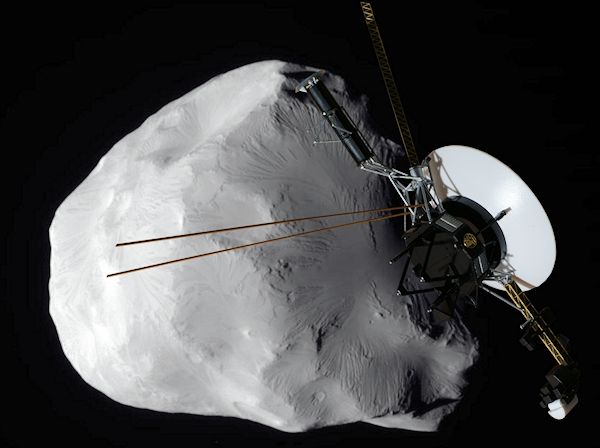 willing
to pay), but also because I have no experience with PE and this didn't seem
to be the place to start. In fact, if you paint the two booms matt black,
and then carefully go over the moulded boom itself with paint (I chose
Tamiya gold, rather than the suggested copper, because it looks closer to
the pictures to my eye), then the whole thing looks pretty good. Especially
if, as I will eventually do, you display the craft against a black
background. You can see in a couple of the photo-montages and also against
my dark wood bench how it's actually pretty effective against a suitable
background. Last of all, if you don't glue the sections of the long boom,
then you can easily remove it if you need to store the kit (for example, if
you move house).
willing
to pay), but also because I have no experience with PE and this didn't seem
to be the place to start. In fact, if you paint the two booms matt black,
and then carefully go over the moulded boom itself with paint (I chose
Tamiya gold, rather than the suggested copper, because it looks closer to
the pictures to my eye), then the whole thing looks pretty good. Especially
if, as I will eventually do, you display the craft against a black
background. You can see in a couple of the photo-montages and also against
my dark wood bench how it's actually pretty effective against a suitable
background. Last of all, if you don't glue the sections of the long boom,
then you can easily remove it if you need to store the kit (for example, if
you move house).
Undoubtedly, the
PE replacement would look better. But if you have average skills, like I do,
then you should know that this kit can still give you a really satisfying
result.
I finished up my Voyager by
painting the base of that cool little stand the same semi-gloss black, and
installing the probe onto it. The globe on the stand is supposed to be
Earth, and if you look closely you'll see it has the land masses of the
northern hemisphere etched onto it. But it so happens that Neptune is a nice
blue colour, so I guess that makes my probe a Voyager 2 in 1989.
Voyager 2 is interesting for so
many reasons, not just to do with spaceflight. The two Voyagers and the two
Pioneers are the only physical evidence of humanity that will leave the
solar system any time soon. They are like ambassadors from our world, in a
way. This kit is excellent for anyone interested in real space, in the whole
"humanity to the stars" thing, or just in something that has a great back
story and looks cool on the shelf. Just watch out for the Klingons,
Hipsters!
If you would like your product reviewed fairly and fairly quickly, please
contact
the editor or see other details in the
Note to
Contributors.
Back to the Main Page
Back to the Review
Index Page


 Voyager
is a really remarkable pair of spacecraft. Both 1 and 2 were launched in
1977, originally designed to fly by Jupiter and Saturn as Pioneers 10 and 11
had done, but with better instruments. But thanks to a once-in-several
lifetimes planetary alignment, engineers were able to send Voyager 2 on a
"planetary grand tour". By clever flying, the probe used gravity assists
from each fly-by to fling itself towards the next giant planet. After
zooming past Saturn in 1981, it cruised through space towards Uranus,
reaching it in 1986, and sling-shotting from there onwards to Neptune. It
reached Neptune in 1989 and is still flying outwards (as is Voyager 1).
Voyager
is a really remarkable pair of spacecraft. Both 1 and 2 were launched in
1977, originally designed to fly by Jupiter and Saturn as Pioneers 10 and 11
had done, but with better instruments. But thanks to a once-in-several
lifetimes planetary alignment, engineers were able to send Voyager 2 on a
"planetary grand tour". By clever flying, the probe used gravity assists
from each fly-by to fling itself towards the next giant planet. After
zooming past Saturn in 1981, it cruised through space towards Uranus,
reaching it in 1986, and sling-shotting from there onwards to Neptune. It
reached Neptune in 1989 and is still flying outwards (as is Voyager 1).  I only
have one concern about the wisdom of the Golden Record. I'm not worried
about a real-life re-run of Star Man. If an alien can really make to earth,
I'm sure he can handle himself without Indiana Jones' girlfriend. And no, I
don't fear that aliens will discover it, then us, and come and wipe us out
with ray guns or some weird galactic venereal disease we have no genetic
immunity to. I have a different concern. And I can't blame Carl Sagan, who
advocated for the record. I mean, they hadn't thought up CDs then, right?
Much less the mp3. A record probably made sense in 1977. But the record has
a different cultural meaning now.
I only
have one concern about the wisdom of the Golden Record. I'm not worried
about a real-life re-run of Star Man. If an alien can really make to earth,
I'm sure he can handle himself without Indiana Jones' girlfriend. And no, I
don't fear that aliens will discover it, then us, and come and wipe us out
with ray guns or some weird galactic venereal disease we have no genetic
immunity to. I have a different concern. And I can't blame Carl Sagan, who
advocated for the record. I mean, they hadn't thought up CDs then, right?
Much less the mp3. A record probably made sense in 1977. But the record has
a different cultural meaning now.  ther
gluing them. In a few spots, primarily on that complex system of booms and
pylons that holds the long golden instrumentation boom, I used a couple of
drops of superglue.
ther
gluing them. In a few spots, primarily on that complex system of booms and
pylons that holds the long golden instrumentation boom, I used a couple of
drops of superglue. willing
to pay), but also because I have no experience with PE and this didn't seem
to be the place to start. In fact, if you paint the two booms matt black,
and then carefully go over the moulded boom itself with paint (I chose
Tamiya gold, rather than the suggested copper, because it looks closer to
the pictures to my eye), then the whole thing looks pretty good. Especially
if, as I will eventually do, you display the craft against a black
background. You can see in a couple of the photo-montages and also against
my dark wood bench how it's actually pretty effective against a suitable
background. Last of all, if you don't glue the sections of the long boom,
then you can easily remove it if you need to store the kit (for example, if
you move house).
willing
to pay), but also because I have no experience with PE and this didn't seem
to be the place to start. In fact, if you paint the two booms matt black,
and then carefully go over the moulded boom itself with paint (I chose
Tamiya gold, rather than the suggested copper, because it looks closer to
the pictures to my eye), then the whole thing looks pretty good. Especially
if, as I will eventually do, you display the craft against a black
background. You can see in a couple of the photo-montages and also against
my dark wood bench how it's actually pretty effective against a suitable
background. Last of all, if you don't glue the sections of the long boom,
then you can easily remove it if you need to store the kit (for example, if
you move house).